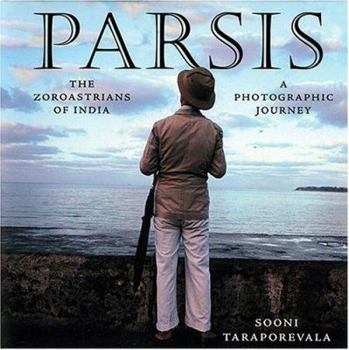Parsis: The Zoroastrians of India: A Photographic Journey
The result of a 20 year labour of love, photographer and screenwriter Sooni Taraporevala's Parsis: The Zoroastrians of India offers a rare insiders view of how the Parsis, a religious and ethnic... This description may be from another edition of this product.
Format:Hardcover
Language:English
ISBN:1585675938
ISBN13:9781585675937
Release Date:October 2004
Publisher:Overlook Books
Length:252 Pages
Weight:4.55 lbs.
Dimensions:1.1" x 11.3" x 11.4"
Customer Reviews
5 ratings
Wonderful
Published by Thriftbooks.com User , 16 years ago
Parsis: The Zoroastrians of India: A PHOTOGRAPHIC JOURNEY is the best dipiction of the Parsis...
The Meaning Of The Term "PARSI"
Published by Thriftbooks.com User , 17 years ago
I have not read the book, but I'm willing to give it the benefit of doubt and give it a rating of "5". The purpose of my "review" is to put the term "Parsi" in its proper perspective. "Parsi" literally means "Persian", since "Pars" is the true name for Persia. If we are to follow this logic, then to all intents and purposes the Zoroastrians in Iran today are the true "Parsis". Therefore, only the second part of the title of this book "The Zoroastrians of India" is correct. The dichotomy can therefore be explained very simply - If you are Indian then you are not "Parsi" and vice versa. One cannot be Persian and Indian at the same time. The Zoroastrians of India have adopted Indian customs and ceremonies, do not speak a word of Persian and therefore do not understand the content of one-third of the Avesta, which is written in Persian. This is tantamount to completely losing their original identity as a people. Blending in with the country of adoption to the point of adopting the language and customs of that country and willingly losing all trace of their origins, and practicing a brand new identity is fine, if they would prefer to do that. However, by labeling themselves as Parsis, they are committing a travesty of justice to the true Parsis in Iran who have practiced the faith against insurmountable odds. And if the Zoroastrians of India are bent upon propagating and promoting their new identity, then they should not create their own sectarian institutions in India but should be willing to blend in with the rest of the Indian community. They cannot have it both ways. And as for not allowing intermarriages or conversions, well, study the Kalme-e-Din in the Avesta. It tells you that the Zoroastrian faith was "sent for the people" (baraye khalk ferestade). That perhaps is the single-most damning evidence against the proponents of non-conversion. But one needs to know the Persian language to understand that. And one last word on this: The Kisse-E-Sanjaan never happened. There is no documented evidence of such an event in the annals of "Parsi" history. And even if it did occur, then it's an affront to scribe a monument in its memory, in Gujerati. That's how far the "Parsis" of India have strayed from their true beginnings. Naming their children with meaningless Persian-"sounding" names will not make them Persians or should I say "Parsis". And as for preventing intermarriages to save the purity of "race", they should take a look in their mirrors and be honest with themselves.
Moving!!!
Published by Thriftbooks.com User , 19 years ago
I bought this book on a whim for a friend and it was one of the best decisions. Sooni's photos really capture a culture and moments in time and help narrate a wonderful experience of sorts. Having visited Bombay several times, I was very impressed by the manner in which she shows the Parsi culture through her simple yet poignant photos. I recommend this book highly! ps- I ended up not only gifting the book to my friend but also bought a copy for myself!!
Wonderful
Published by Thriftbooks.com User , 19 years ago
This isn't a book just for Parsis- it's a perfect combination of veritable art and wonderful writing. The Parsi community is one of great diversity, and Sooni Taraporevala's "The Parsis" brings this variety to light in a way that few other publications have successfully managed. Not only does her book stride the cultural spectrum, but it captures each facet beautifully; heart-wrenchingly so, and one can scarcely imagine another picture that could capture the moment more eloquently. The accompanying narratives are also insightful in the extreme and lack the posturing and false grandiosity that riddles so many other publications that try to infuse a sense of pride and wonder in the reader. This is a book that I am bound to use when explaining my heritage and background, not only to non-Parsis, but to future generations of Parsis here in North America. A wonderful book that I'd recommend to anyone.
Celebrated Parsi filmmaker captures essence of Parsis in...
Published by Thriftbooks.com User , 19 years ago
Whether you are a Parsi or not, this book is a joy to behold. Ms. Taraporevala has captured the many facets of Parsis through their daily lives through essays and haunting photography. Her photo documentary weaves a loose story from training for the priesthood to the final passage of life. Her personal essays and photos of family members allow the reader to get a glimpse of what it means to grow up as a Parsi in Bombay. This book is probably the first photo documentary book about Parsis and it will be a real asset in shedding light on a group that is little understood in the world today.




